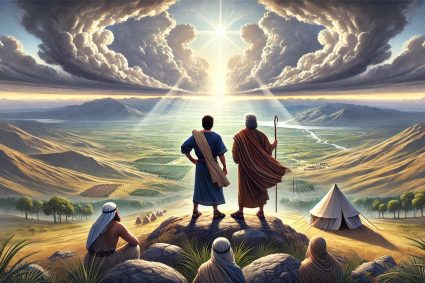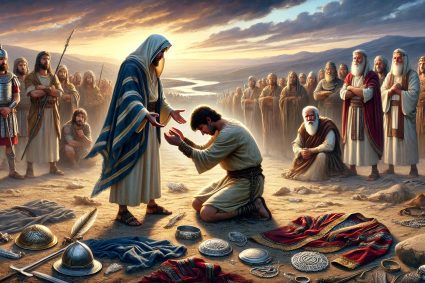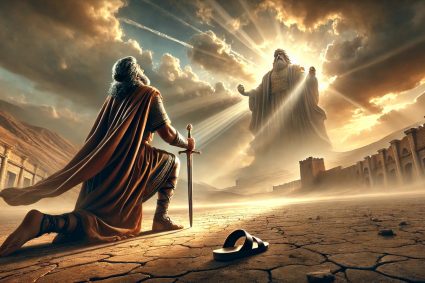
Series ALLUSIONS, IMAGES, SYMBOLS with Pastor Mark Finley
Lesson 10.Upon Whom the Ends Have Come
Ready for the Final Hour – God Judges and Saves
Lesson 10 takes us on a journey through central end-time scenarios of the Bible, beginning with the wrath of the Lamb and ending with the pre-advent judgment. We meet Noah, who built unwaveringly on God’s word, and Abraham, who deepened the understanding of divine justice in conversation with God. The tragic examples of Sodom and Gomorrah warn us of the consequences of unrepented sin, while Daniel 7 reveals the final divine judgment under the Son of Man, Jesus. Throughout these accounts runs the golden thread of God’s sovereignty, grace, and transparency in the plan of salvation. This lesson encourages us to remain watchful, examine our hearts, and tirelessly proclaim the gospel until the final hour.
Content:
10.1 The Wrath of the Lamb
When the Lamb is Angry – The Final Hour of Grace
In Revelation 6:12–17, we see heaven and earth trembling, and humanity frightened before the wrath of the Lamb—even though they know His story. Interestingly, the lost do not complain about a lack of information, but about their hopeless condition: they acknowledge the judgment, yet don’t know how to escape. Their cry, “Who can stand?” reveals that knowledge alone does not save, but obedience and faith. Noah’s time already shows in Matthew 24:36–44 that warnings and commandments do not prevent many from being caught unprepared. The increasing attitude of mockery (2 Peter 3:3–4) stretches the apparent delay—until the hour of decision strikes each individual. This awareness should prompt us to remain alert and continue proclaiming the gospel until “the day” truly comes.
10.2 Noah’s Evangelism
Steadfast in the Call to Salvation
Noah’s century-long building of the ark shows us that obedience precedes understanding: he acted on God’s word, even when no visible results were seen. Many still dismiss the flood as a myth today, even though it is clearly attested in Scripture and tradition. Just as in Noah’s time, the moral atmosphere was filled with lawlessness and rejection of divine guidance (Genesis 6:1–8). This teaches us that our proclamation of the “Three Angels’ Messages” must not depend on numerical success but on faithful witness. Jesus Himself reminds us in John 4:37 that sowing and reaping have their seasons—we sow, even if we do not yet see the growth. Thus, we remain in service, knowing that God will complete His “work of grace” when the time is fulfilled.
10.3 The Story of Sodom and Gomorrah
When the Fire of Judgment Falls – Lessons from Sodom and Gomorrah
The destruction of Sodom and Gomorrah shows how deep wickedness and spiritual adultery can bring an entire people to ruin (Ezekiel 16:46–50). Peter and Jude directly connect this Old Testament judgment with the end times to warn us that we too will be judged by fire if we persist in sin (2 Peter 2:4–11; Jude 5–8). Shockingly, Israel in its spiritual arrogance acted worse than those cities—a sharp image of how complacency blinds us (Ezekiel 16:47). Paul adds that the worst transgressions arise precisely when we consider ourselves morally superior (Romans 1:18–32). Like David, who only recognized his own guilt through Nathan’s parable, the story of Sodom and Gomorrah calls us to honestly examine our own hearts before judging others. In this way, God’s Word protects us from self-deception and leads us to repentance.
10.4 The Judge of All the Earth
The Righteous Judge Grants Insight Before the Final Judgment
In Genesis 18:17–32, God reveals Himself as the one who discloses His judicial process and grants Abraham’s intercession before destroying Sodom and Gomorrah. This conversation reveals His nature: He judges with justice, not arbitrarily, and listens to the pleas of the righteous. By inviting Abraham to explore the threshold of righteousness—“Shall not the Judge of all the earth do right?”—God shows His willingness to be examined by His creation. The same openness is reflected in the millennium (Revelation 20), when the heavenly books are reviewed. It becomes clear: God’s character combines perfect holiness with patient transparency, even in the face of final judgment.
10.5 The Pre-Advent Judgment
Before the Throne of the Son of Man – God’s Redemptive Judgment
In Daniel 7:9–10,13–14,22,26–27, we witness the pre-advent judgment, where “the Son of Man,” Jesus, comes before the throne and proclaims that justice is given to the saints of the Most High. The main focus of this heavenly court is not revenge but the final affirmation and vindication of those who are in covenant with Christ. The books are opened so that both angels and humans may review the entire plan of redemption. In the end, the verdict declares that the eternal kingdom belongs to the Son and His saints—evidence that God’s grace and justice are united in Him. Therefore, our only hope in this judgment is not our own merit but the perfect righteousness of the One who atoned for us.
10.6 Summary
When the Final Hour Strikes – Insights for the End Times
Lesson 10 takes us through key accounts—from the warnings of the Lamb’s judgment to Noah’s patient preaching and the destruction of Sodom and Gomorrah—to reveal God’s character as both righteous Judge and merciful Redeemer. We see how God’s wrath and mercy go hand in hand: He warns His people, tests their willingness to repent, and grants deep insight into His decision-making. The image of the pre-advent judgment in Daniel 7 presents Jesus as the substitute advocate and judge, whose perfect righteousness saves His people. Each biblical story reminds us that information alone is not enough—we must allow our hearts to be transformed. Thus, Lesson 10 reminds us that the gospel must be proclaimed until the very end, and our only security when the final hour comes lies in the grace of Christ.
(Visited 4 times, 1 visits today)




















